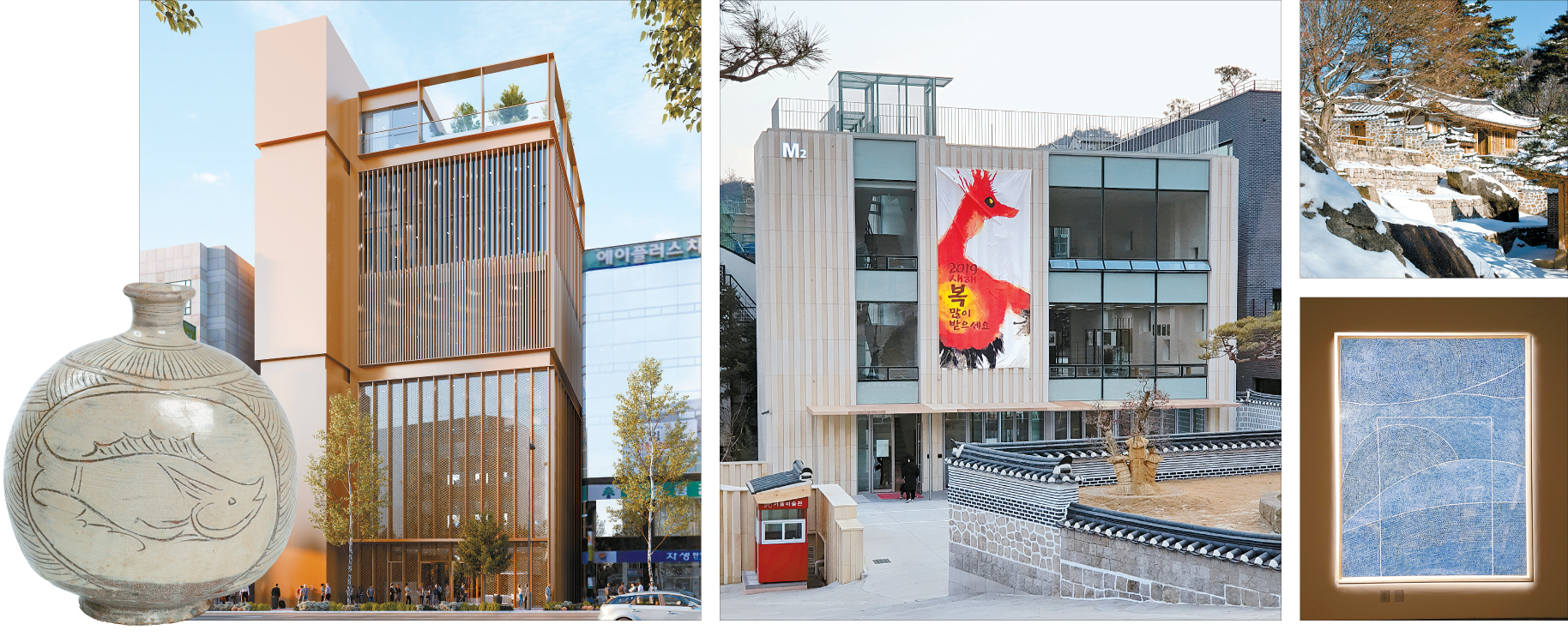2019 brings along more art spaces to Seoul: Seoul Auction and Seoul Museum hope to attract new crowds

Celebrating the opening of the new Gangnam Center in Sinsa-dong, southern Seoul, above left, Seoul Auction is holding an exhibition of buncheong ware, far left. The Seoul Museum, central Seoul, which is also home of Seokpajeong Pavilion, far right, also opened a new building, above center, and is presenting its new collection there, including Kim Whanki’s painting, far right. [SEOUL AUCTION, SEOUL MUSEUM, MOON SO-YOUNG]
Seoul Auction, the country’s largest art auction house, opened its new branch called Gangnam Center in Sinsa-dong, southern Seoul, on Jan. 18.
The building, with eight stories above ground and five stories underground, was designed by famous French architect Jean-Michel Wilmotte, whose signature works include the Incheon International Airport’s interior design and LVMH’s new Paris headquarters. The architect also designed Seoul Auction’s headquarters in Pyeongchang-dong, central Seoul, in 1998.
“I hope the Gangnam Center will help the general public feel more familiar with art auctions and feel free to participate in them,” said Lee Ok-kyung, CEO and vice chairwoman of Seoul Auction.
The remark suggests the auction house’s Gangnam Center will target younger art collectors, many of whom are residing in Gangnam. Pyeong- chang-dong, where its headquarters are located, has long been favored by so-called “old-money” families.
Celebrating the opening, the auction house held an online auction entitled “My First Collection” on Thursday, to offer less costly art pieces to early collectors. The Gangnam Center also opened an offline inaugural exhibition, which features buncheong ware, or greyish-blue ceramic covered in coarse white glaze, along with abstract paintings by such artists as Lee Ufan and Ha Chong-hyun.
In recent years, Seoul Auction has been actively extending its business and spaces. Its subsidiary, Seoul Auction Blue, launched an offline and online marketplace brand “Rare by Blue” for trading art toys and design products.
Meanwhile, the Seoul Museum, a private museum located at the foot of Mount Inwang, central Seoul, opened a new building at its scenic site in November.
The new building, with three stories above ground and one story underground, has a view of Seokpajeong Pavilion, which also stands on the museum site. The 19th-century hanok was once a summer house of the powerful Prince Regent Daewongun (1820?1898), father of King Gojong. The house is famous for its beautiful garden that makes good use of the mountain’s rugged rocks, streams and handsome pine trees.
The new building is currently the home of two exhibitions running through Feb. 10. One of them is a solo show of French artist Paul Jacoulet (1896-1960). He studied ukiyo-e woodblock prints, which flourished in the 17th, 18th and 19th centuries in Japan. He traveled to Korea several times and visualized his impressions through the ukiyo-e-style prints.
The other is “Walking Man,” which features the new collection of the museum, including “One Hundred of Thousands of Dots 04-VI-73 #316”(1973) by Korean modern art master Kim Whanki (1913-74), who is now the world’s most sought-after Korean artist.
The painting is considered to be one of Kim’s most beautiful ‘New York era’ allover dot paintings, which are regarded as the peak of Kim’s oeuvre and have set art market records at auctions in Seoul and Hong Kong in recent years.
BY MOON SO-YOUNG [symoon@joongang.co.kr]










with the Korea JoongAng Daily
To write comments, please log in to one of the accounts.
Standards Board Policy (0/250자)